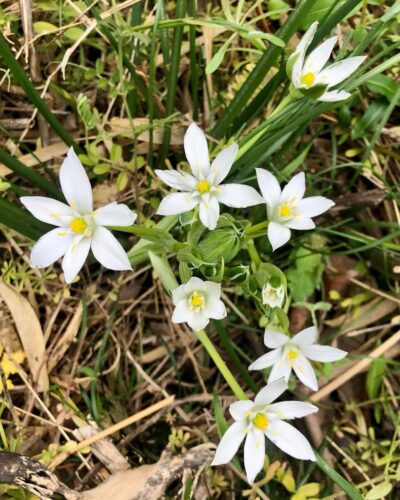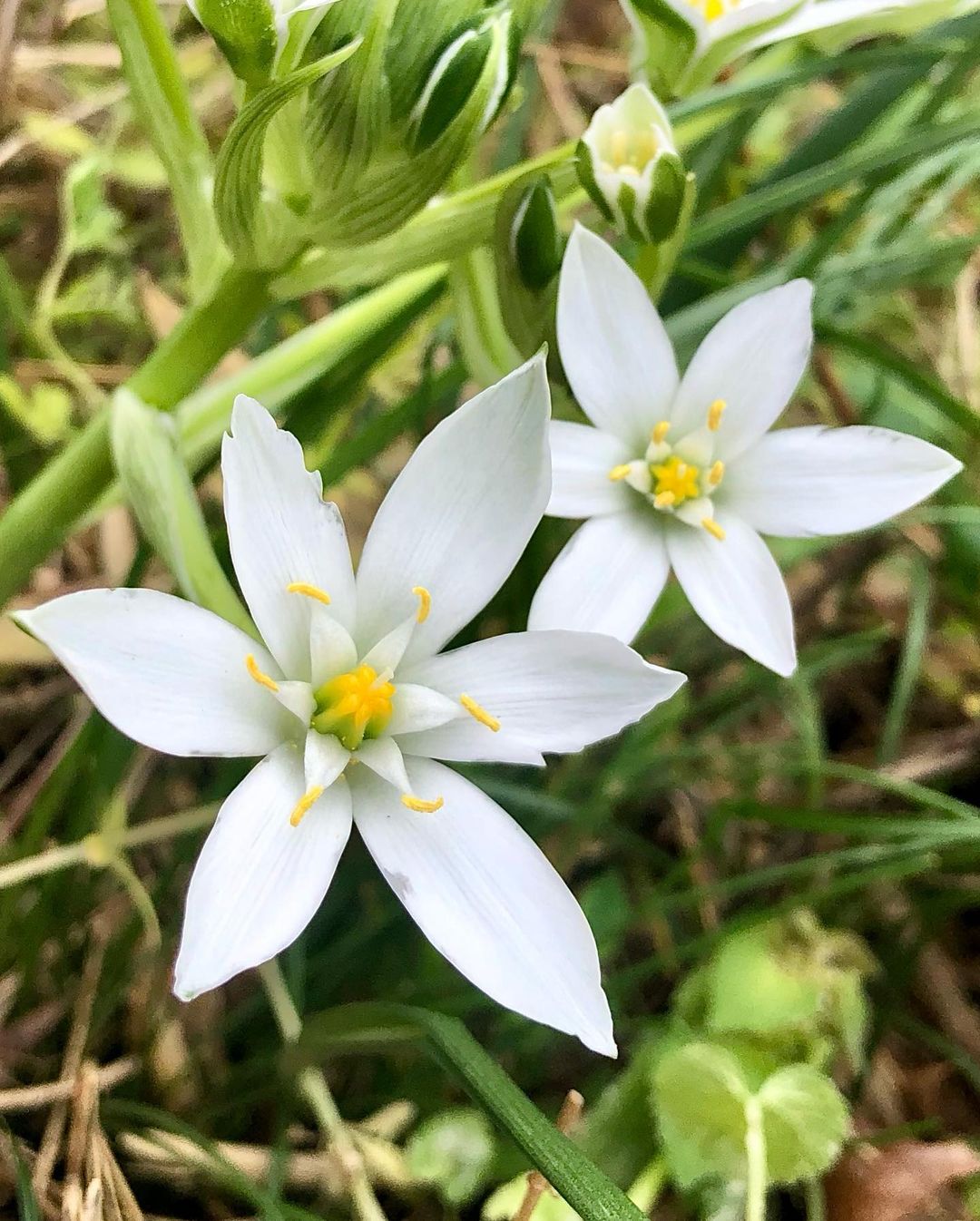Star of Bethlehem Flower Care is not difficult if you have the right knowledge to nurture these stunning blooms for lively displays.
Read the details of Star of Bethlehem Flower Care and learn how to create a stunning garden filled with enchanting beauty.
Common Names: Star of Bethlehem, summer snowflake, nap-at-noon, grass lily, sleepy dick, eleven-o’clock lady
Botanical Name: Ornithogalum umbellatum
USDA Zones: 4-9
Read: Thunbergia Erecta Clockvine Care
What is the Star of Bethlehem Flower?

The Star of Bethlehem (Ornithogalum umbellatum) is a perennial bulb that forms dense clusters of slender, grass-like leaves. It can typically reach a length of about 1 foot. During late spring, elegant flower stems emerge from the foliage, each adorned with approximately 10 to 20 star-shaped blossoms measuring less than an inch in diameter. These charming flowers unfurl in the late morning, closing at sunset or during overcast conditions.
Known for its rapid growth, the Star of Bethlehem readily multiplies, making it an excellent addition to any garden. To enjoy its springtime blooms, plant the bulbs in the fall.
Note: However, it’s important to note that the Star of Bethlehem can be invasive in certain regions.
Propagating Star of Bethlehem
Over time, the bulbs of the Star of Bethlehem will multiply abundantly, giving rise to small bulbils or offsets. If you wish to propagate this plant, here is a step-by-step guide:
- Use a shovel or trowel and carefully excavate the bulbs in late summer when leaves start to wither. Gently separate the attached offset bulbils from the parent bulb.
- Instantly transplant both the bulbils and parent bulbs into moist, well-draining soil. Ensure that they are buried at a depth of 3-6 inches and spaced approximately 4 inches apart.
- The smallest bulbils might take up to two years to mature and produce flowers.
How to Grow Star of Bethlehem From Seed
If you wish to control the spread of Star of Bethlehem flowers, it is recommended to deadhead the blossoms by removing the faded blooms before they release their seeds.
This practice helps prevent self-seeding and reduces the number of volunteer plants that sprout around the parent plant. However, it’s important to note that even with deadheading, it may still take a few years for transplanted volunteers to grow mature bulbs capable of producing flowers.
Planting Star of Bethlehem
- For successful growth, plant Star of Bethlehem bulbs 3-6 inches deep in well-draining, moist soil with the pointed end facing up. Allow 4 inches of spacing between bulbs.
- Optimal flowering occurs in sunny locations, though partial shade is acceptable.
- In colder zones, protect bulbs with a 3-inch layer of winter mulch, removing it once the ground fuses in spring for plant emergence.
Alert: Star of Bethlehem, a plant known for its rapid multiplication and self-seeding, has naturalized in various regions of North America. Due to its invasive nature, it is advised to consult local experts and be cautious before introducing this plant to your garden.
Read: Passiflora Caerulea Growing Guide
Types of Ornithogalum
The Star of Bethlehem flower, although lacking named cultivars, belongs to the Ornithogalum genus, which contains around 200 other species. These species share similarities with the Star of Bethlehem and offer a diverse range of options for flower enthusiasts.
- Ornithogalum dubium: It offers orange flowers; this species stands at a modest height of approximately 10 inches. It thrives in zones 7 to 10.
- Ornithogalum nutans: It can reach a height of about 16 inches; this species displays white flowers with prominent green accents. This variety is suitable for growth in zones 6 to 10.
- Ornithogalum arabicum: With a height of approximately 19 inches, this plant showcases elegant white flowers. It thrives in zones 9 to 10, showcasing its hardiness.
- Ornithogalum thyrsoides: Standing at a height of about 16 inches, this species boasts charming white flowers. It exhibits resilience in zones 7 to 10, making it a hardy choice.
Ideal Growing Condition for Star of Bethlehem Flower

Location
While Star of Bethlehem can tolerate partial shade, it grows best in a location that receives plenty of sunlight, ideally six or more hours of direct sunlight on most days. Optimal flowering of this plant is achieved when it is grown in full sun.
Soil
Use loamy soil that offers sharp drainage, which is crucial for its healthy growth. It is important to avoid waterlogged soil as it can lead to bulb rot.
Water
For young Star of Bethlehem plants, it is important to provide regular watering to maintain even moisture in the soil without making it soggy. Mature plants exhibit some tolerance for dry soil but still prefer a moderate level of moisture.
During the active growth period in spring and summer, water the plant when the soil feels dry, around a couple of inches deep. When the plant enters its dormant phase, its moisture requirements decrease and additional watering is generally unnecessary. Cease watering once the foliage starts turning yellow after the flowers have wilted.
Temperature and Humidity
The Star of Bethlehem exhibits a remarkable resilience to temperature extremes within its growing zones (4 to 9).
It generally withstands varying humidity levels without major concerns as long as its soil moisture requirements are adequately met.
Read: Red Spider Lily Growing Tips
Star of Bethlehem Flower Care
Fertilizer
To achieve optimal flowering, grow the Star of Bethlehem in nutrient-rich soil. Each spring, blend compost into the soil to support robust growth. It is important to note that additional fertilization is unnecessary and may potentially block the flowering process.
Pruning
After the blooming period of the Star of Bethlehem, the foliage may appear tangled and unappealing. However, it is important to resist the temptation of removing the foliage while it remains green. The green foliage continues to nourish the bulbs through photosynthesis. Eventually, the leaves will turn brown, and the plants will enter their dormant phase during the summer. At this point, the foliage can be safely removed, leaving gaps in the garden bed.
Some gardeners choose to fill these gaps with annual plants, while others plant perennials next to their Star of Bethlehem, allowing them to fill in the space throughout the summer gradually.
While deadheading the spent flowers does not stimulate additional blooming, it does prevent the spread of the plant by eliminating the seeds that can easily germinate wherever they fall in the garden.
Repotting
Due to its short bloom season and subsequent foliage die-back, the Star of Bethlehem is not commonly grown in containers. Nevertheless, there is no restriction on growing it in a well-draining pot made of any material, filled with standard commercial potting mix.
Once the pots have bloomed and the foliage has withered, it is advisable to relocate them to a sheltered area away from sight for overwintering. They can then be reintroduced to an open setting the following spring.
Overwintering
Star of Bethlehem, within its hardiness range of zones 4 to 9, is known for its resilience against the winter cold. Nevertheless, gardeners residing in the northern regions of Zone 4 may consider safeguarding plants in exposed areas by applying a layer of dry mulch during winter.
It is important to prevent the bulbs from being soaked in cold, wet ground, as this can promote bulb rot. In extremely cold areas, an alternative option is to dig up the bulbs and store them in a protected space such as a basement.
Pests and Diseases
It is generally not susceptible to significant pest issues. The only notable disease that can affect it is bulb rot, which occurs in poorly draining and infertile soils.
Toxicity
Star of Bethlehem is toxic to both humans and animals.
Read: Arum Lily Care and Growing Guide
How to Force Star of Bethlehem to Bloom
Star of Bethlehem typically displays a striking abundance of white flowers during May and June, with each stem bearing 10 to 20 charming, starry white blooms. The flowers tend to open around midday and close at sunset or when the sky is overcast.
Insufficient sunlight, excessive nitrogen-rich fertilizer, or immature bulbs can hinder proper flowering. It may take up to two years for propagated offsets to mature enough to produce flowers, while plants grown from seeds can require an even longer period before blooming.



